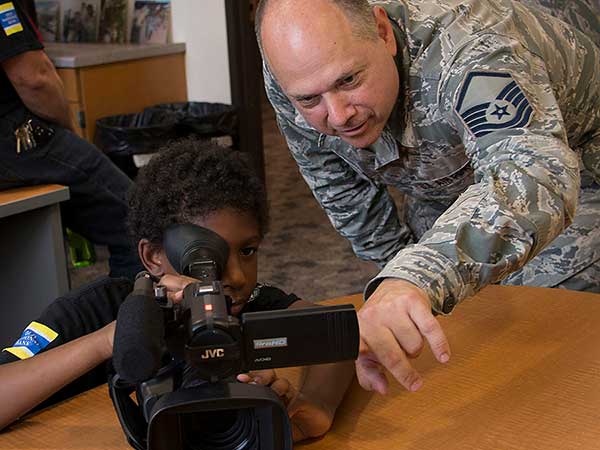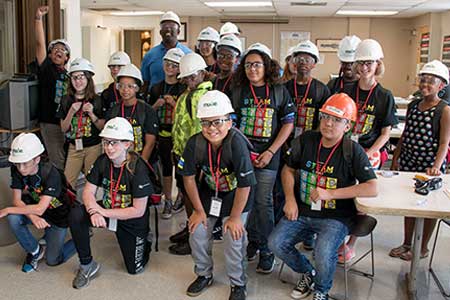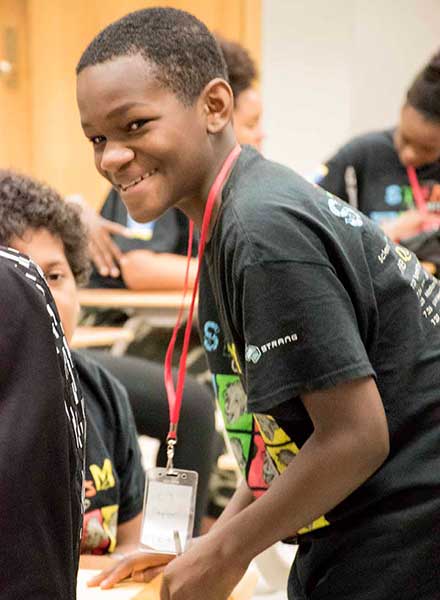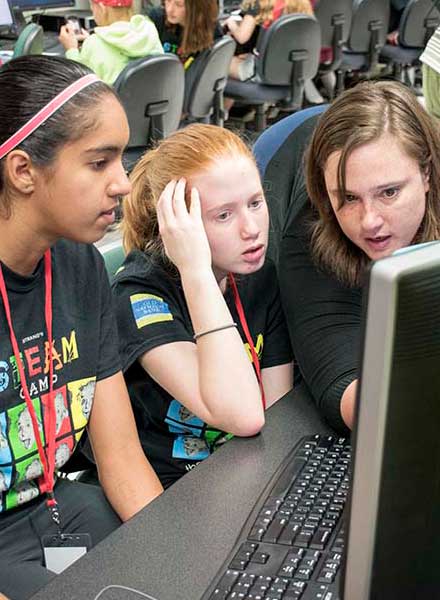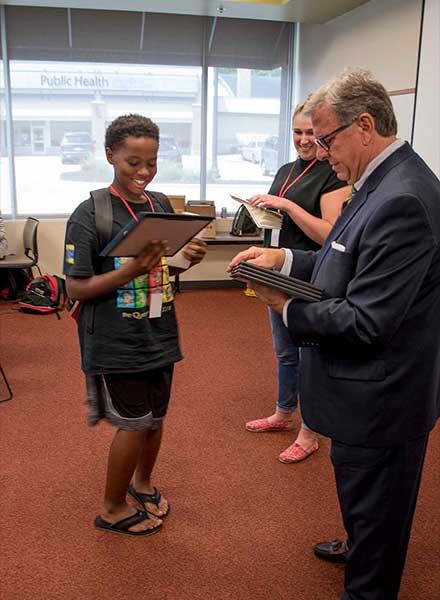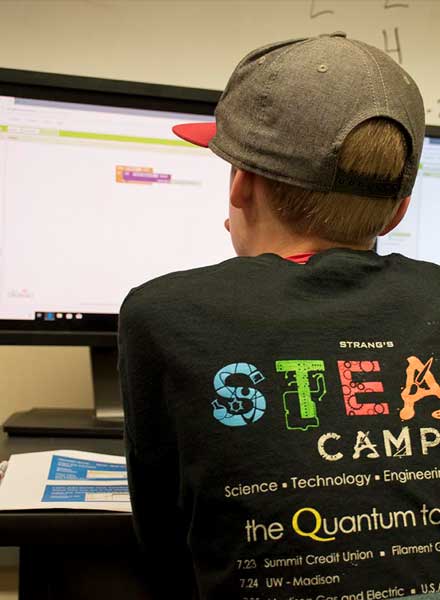What do you get when you mix 50 middle school students, a major university, three non-profits and private enterprise? Opportunities for the future.
Each day was a different experience as they wheeled around the Capitol Region in a yellow school bus. They visited the U.S. Air Force Base at Truax Field and went inside of Filament Games, a company which designs educational video games.
The program was once again a community effort. The Greater Urban League of Madison, Big Brothers Big Sisters of Dane County, Girl Scouts of Wisconsin Badgerland and the Ho-Chunk Nation brought the children into the program.
Generous hosts – a mix of public and private enterprises – opened their doors and their resources to the campers. Old National Bank helped with funding and Ian’s Pizza provided more than enough sausage pepperoni and cheese pizza.
Generous hosts – a mix of public and private enterprises – opened their doors and their resources to the campers. Old National Bank helped with funding and Ian’s Pizza provided more than enough sausage pepperoni and cheese pizza.
OUR THIRD ANNUAL STEAM CAMP
Strang’s third annual STEAM Camp is designed to open educational pathways for children prior to entering high school. That effort starts by opening the children’s eyes, minds and hearts to a variety of career choices, and doing so in settings outside of a traditional classroom.
For five days in July, campers got to see behind-the-scenes stuff that few in Madison ever see, including views from some of the highest buildings in the city and some of the coolest technology in the state. They met business leaders, college professors, doctors, helicopter pilots and soldiers with the U.S. Air Force. They ate pizza, tacos, ice cream and cake. They learned how to make a family budget, design a video game and create a small wind turbine. They studied the science behind DNA and tried their hands at computer programming.
Each day was a different experience as they wheeled around the Capitol Region in a yellow school bus. They visited the U.S. Air Force Base at Truax Field and went inside of Filament Games, a company which designs educational video games.
For five days in July, campers got to see behind-the-scenes stuff that few in Madison ever see, including views from some of the highest buildings in the city and some of the coolest technology in the state. They met business leaders, college professors, doctors, helicopter pilots and soldiers with the U.S. Air Force. They ate pizza, tacos, ice cream and cake. They learned how to make a family budget, design a video game and create a small wind turbine. They studied the science behind DNA and tried their hands at computer programming.
Each day was a different experience as they wheeled around the Capitol Region in a yellow school bus. They visited the U.S. Air Force Base at Truax Field and went inside of Filament Games, a company which designs educational video games.
The program was once again a community effort. The Greater Urban League of Madison, Big Brothers Big Sisters of Dane County, Girl Scouts of Wisconsin Badgerland and the Ho-Chunk Nation brought the children into the program. Generous hosts – a mix of public and private enterprises – opened their doors and their resources to the campers. Old National Bank helped with funding and Ian’s Pizza provided more than enough sausage pepperoni and cheese pizza.
MONDAY: SUMMIT CREDIT UNION AND FILAMENT GAMES
Each day of STEAM Camp began at the Urban League of Greater Madison where campers gathered to check in and await their school bus that would take them to a new adventure. On Monday morning, the kids were dropped off at the Madison Central Library just blocks from the State Capitol for a financial literacy program hosted by Summit Credit Union.
The kids worked on a simulated household budget. Each was randomly given a career, spouse, number of children and tasked with planning a budget including both long-term and short-term goals. They were given options of choosing apartment living or purchasing a house, buying a new car or used car and saving or spending additional funds.
The kids worked on a simulated household budget. Each was randomly given a career, spouse, number of children and tasked with planning a budget including both long-term and short-term goals. They were given options of choosing apartment living or purchasing a house, buying a new car or used car and saving or spending additional funds.
They learned the challenges of staying within their budgets and handling the pressures of student loans, credit card debt and retirement savings. Some campers said they better appreciated their parents’ responsibilities after the program.
After a lunch donated by Ian’s Pizza in Madison, the kids walked two blocks to Filament Games, a developer of educational video games. Part of the STEAM Camp’s key missions is to create innovative ways to play, learn and interact in an expanding digital world. At Filament Games, they played a video game using a virtual reality headset and mapped-out a video game by using logic and creativity.
After a lunch donated by Ian’s Pizza in Madison, the kids walked two blocks to Filament Games, a developer of educational video games. Part of the STEAM Camp’s key missions is to create innovative ways to play, learn and interact in an expanding digital world. At Filament Games, they played a video game using a virtual reality headset and mapped-out a video game by using logic and creativity.
TUESDAY: DISCOVERY TOWN CENTER & UW’S BIOTECHNOLOGY CENTER.
On Tuesday, the kids split into two groups, with half the kids starting at the Discovery Town Center on the University of Wisconsin campus, and the rest going to UW’s Biotechnology Center.
They toured the Discovery Center, experiencing modern technology marvels of light and sound and learning facts about science and history. As part of the incentive to discover the facts, they participated in a scavenger hunt in the center.
During their visit to the Biotechnology Center, campers learned about DNA then performed simple experiments to extract DNA from a sample liquid.
They toured the Discovery Center, experiencing modern technology marvels of light and sound and learning facts about science and history. As part of the incentive to discover the facts, they participated in a scavenger hunt in the center.
During their visit to the Biotechnology Center, campers learned about DNA then performed simple experiments to extract DNA from a sample liquid.
The group remained split in the afternoon with half visiting the UW Physics Museum while others started with a visit to the Space Science and Engineering Center on campus.
At the Space Center, they learned how scientists use space, aircraft and ground-based instruments to collect and analyze the atmosphere of earth and other planets. Campers then went to the building’s rooftop – the second-highest building in the city – for a tremendous summertime view of the city of Madison and its three lakes.
The Physics Museum provided students and opportunity for hands-on learning of concepts from mechanics to modern physics. Finally, on this hot July afternoon, campers finished with a serving of delicious ice cream from UW’s Babcock Hall.
The Physics Museum provided students and opportunity for hands-on learning of concepts from mechanics to modern physics. Finally, on this hot July afternoon, campers finished with a serving of delicious ice cream from UW’s Babcock Hall.
WEDNESDAY: MADISON GAS AND ELECTRIC & TRUAX FIELD
Campers began Wednesday with a visit to Madison Gas and Electric, learning vital details about the utility’s wide network of people, places and equipment that bring power to homes and businesses throughout the Greater Capitol Region.
After donning hard hats and goggles, they toured the MG & E power plant, discovering first-hand the power and heat produced there and learning about careers of people who keep the plant running. Then they stepped outside to learn about renewable energy, first with an introduction to electric cars and then to the rooftop where rows of solar panels pulled in energy from the sun. Back inside, the kids learned how to make their own wind turbines out of wooden dowels and paper, testing them out by holding them in front of box fans.
After donning hard hats and goggles, they toured the MG & E power plant, discovering first-hand the power and heat produced there and learning about careers of people who keep the plant running. Then they stepped outside to learn about renewable energy, first with an introduction to electric cars and then to the rooftop where rows of solar panels pulled in energy from the sun. Back inside, the kids learned how to make their own wind turbines out of wooden dowels and paper, testing them out by holding them in front of box fans.
In the afternoon, campers rode out to Truax Field, home to the 115th Fighter Wing of the Air National Guard. They learned that the National Guard base is much more than just a collection of pilots and fighter jets, touring everything from the fire station, photo studio, hydraulic shop and more. The campers marched alongside military veterans from building to building on the base, speaking with soldiers with a variety of professional roles on the base.
THURSDAY: CLINICS & THE OVERTURE CENTER
Groundbreaking medical procedures and lifesaving techniques are daily occurrences at the University of Wisconsin Hospital and Clinics. On this Thursday morning, the 48 STEAM Campers visited various departments inside the health campus to learn about health-related career fields.
They got to see and touch (while wearing gloves) human organs, experienced how difficult it is to move with a brain injury by wearing a set of special goggles, and even broke into teams to play a round of health Jeopardy. Then they went onto another rooftop, this time to view the helipad where the Flight for Life Helicopter is based. One group of kids watched the chopper take off, from a vantage point safely inside the hangar.
Campers used the right side of their brain on Thursday afternoon during their visit to the Overture Center in downtown Madison. The program on arts began with a behind-the-scenes tour of this performing arts center and gallery.
They got to see and touch (while wearing gloves) human organs, experienced how difficult it is to move with a brain injury by wearing a set of special goggles, and even broke into teams to play a round of health Jeopardy. Then they went onto another rooftop, this time to view the helipad where the Flight for Life Helicopter is based. One group of kids watched the chopper take off, from a vantage point safely inside the hangar.
Campers used the right side of their brain on Thursday afternoon during their visit to the Overture Center in downtown Madison. The program on arts began with a behind-the-scenes tour of this performing arts center and gallery.
The students broke up into small groups for interactive programs including ballet basics and acting out parts from a play. These programs brought out their creative and sometimes silly side. Finally, the group heard from a panel of people from a variety of art-related fields to get a better perspective on future careers.
FRIDAY: UW DEPARTMENT OF COMPUTER SCIENCES
Friday, the last day of STEAM Camp, included a half-day program followed by a celebratory lunch at the Urban League including parents, family and friends.
The bus took the campers to the UW Department of Computer Sciences where they learned from Faculty Associate Tracy Lewis-Williams, the logic involved in programming computers. She led them in games that included working in teams while one child covered their eyes or ears to remove one sense and still figure out wat the team was trying to communicate.
Students visited other areas of the department, watching a small robot perform a rap song and then sitting down at computer stations for hands-on computer science education.
Back at the Urban League, each camper received a certificate of achievement for their efforts throughout the week. The festivities included lunch, cookies and – of course – a STEAM Camp cake.
The bus took the campers to the UW Department of Computer Sciences where they learned from Faculty Associate Tracy Lewis-Williams, the logic involved in programming computers. She led them in games that included working in teams while one child covered their eyes or ears to remove one sense and still figure out wat the team was trying to communicate.
Students visited other areas of the department, watching a small robot perform a rap song and then sitting down at computer stations for hands-on computer science education.
Back at the Urban League, each camper received a certificate of achievement for their efforts throughout the week. The festivities included lunch, cookies and – of course – a STEAM Camp cake.



















